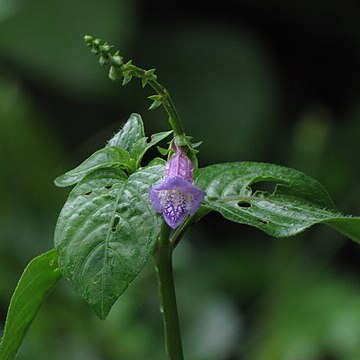Perennial herb 10-60 cm tall, becoming decumbent, stems cylindrical, pubescent. Leaves petiolate, pubescent; lamina up to 10 cm long and 3 cm broad, highly variable in size and shape, ovate to linear; leaf margin entire or obscurely toothed, apex rounded; venation pinnately reticulate with 4-7 lateral vein pairs. Inflorescence terminal, a scorpioid cyme, rarely branched, peduncle with stalked glandular and filiform eglandular trichomes, bearing 2-10 flowers singly 20-15 mm apart, two minute deltoid bracteoles and a larger bract subtend the flowers. Calyx pentamerous, divided to the base, calyx lobes linear lanceolate, 7-10 x 0.75-1 mm, pubescent bearing stalked glandular and filiform eglandular trichomes externally. Corolla pentamerous, slightly bilabiate, connate forming a tube 3.5-4.0 cm long, linear in the basal 0.3-0.5 and dilated distally, glabrous within and glandular without; lobes about 7 x 5 mm, lateral lobes acute, lower median lobe rounded, with a raised palate and bold violet nectar guides. Stamens 4, epipetalous, didynamous, filaments glabrous; anthers bithecous, muticous with rounded bases, thecae slightly divergent 1.5-2.5 mm long, one placed slightly above the other. Pollen perprolate, 32-35 x 15-20 µm, tricolporate, with 4 pseudocolpi flanking each colpus, inner pseudocolpi fused terminally, poles apocolpoid. Ovary oblong, 3-4 x 2 mm, slightly compressed with sessile, papillate glands, although these are stalked on the ovary/style junction; style glabrous, filiform and arcuate. Stigma deeply bifid with spathulate stigma lobes. Capsule loculicidal, compressed, composed of an infertile stipe about 15 mm long and a locular portion about 15 mm long, bilocular with 2 seeds per locule. Seeds laterally compressed, pyriform, 5-6 mm long, with longitudinal rugae.
More
Perennial herb, becoming decumbent, 0.1-0.6 m high. Inflorescence a scorpioid cyme. Calyx with stalked, glandular trichomes with pigmented head cells. Corolla light purple, narrow throughout, longer than calyx lobes. Stamens: anthers, filaments and connectives glabrous. Stigma spathulate. Flowering time Oct.-Feb. Seeds discoid with a reticulate pattern of elongated tubercles.

